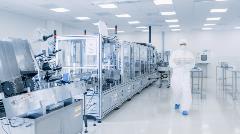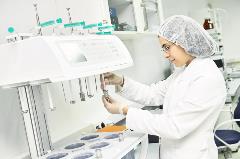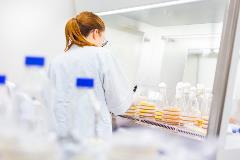Introduction to Low Bioburden Cleanrooms
Many medical device manufacturers have cleanrooms compliance with ISO 14644, which focuses on “cleanliness” as defined by low particulate counts. Certain medical devices—such as ventilators and face masks—require cleanrooms to also maintain a low bioburden count.
Bioburden is defined as the number of bacteria living on a surface, and is measured in CFU (Colony Forming Units). These medical devices have seen a significantly higher demand recently due to the global outbreak of COVID-19, and many medical device manufacturers can easily adapt their current cleanrooms to support the effort to meet the higher demand for these devices.
 As the ISO 14644 standard does not provide requirements for bioburden, the default for bioburden limits is the EU GMP Annex 1, which provides a criteria for bioburden control levels.
As the ISO 14644 standard does not provide requirements for bioburden, the default for bioburden limits is the EU GMP Annex 1, which provides a criteria for bioburden control levels.
In this standard, a low bioburden cleanroom is classified as a Grade D cleanroom, which generally aligns with the requirements for an ISO Class 8 cleanroom. The key element which sets these two classifications apart is the need for bioburden testing. Barry-Wehmiller Design Group has extensively compared these two cleanroom classifications and is well-versed in designing, constructing, converting, and maintaining cleanrooms of this caliber.
Environmental Conditions in Low Bioburden Cleanrooms
Similar to an ISO Class 8 cleanroom, particulate counts for the Grade D cleanroom “at rest” are required for particle sizes ≥0.5µm and ≥5.0µm. The requirements for particulate levels can be seen in Table 1:
Table 1: Particulate Count Maximums
|
Room Classification
|
≥0.5 µm
|
≥5.0µm
|
|
ISO Class 8
|
3,520,000
|
29,300
|
|
Grade D
|
3,520,000
|
29,000
|
Other similarities between the two cleanroom classifications include effective air circulation with in-line filtration (i.e. HEPA filters), air change rate between 5 – 48 changes/hour (ACH), and positive differential pressures between cleanroom spaces and lower classification spaces. However, the recommended minimum differential pressure for Grade D cleanrooms is 0.04” w.c.; the recommended minimum differential pressure for ISO Class 8 cleanrooms is 0.02” w.c. This Differential Pressure difference helps maintain bioburden control, as bacteria is smaller (<0.2 µm) than defined particulate criteria.
Bioburden Measurements for Grade D Cleanrooms
 To ensure an ISO Class 8 cleanroom also meets the requirements for Grade D cleanrooms, Environmental Monitoring must be performed. Environmental Monitoring for low bioburden may include air viable samples, settling plates, and contact plates. The measured growth from the plates are used to determine how much bioburden was in each sampled area. The maximum colony forming unit (CFU) requirements for a Grade D cleanroom are specified in Table 2:
To ensure an ISO Class 8 cleanroom also meets the requirements for Grade D cleanrooms, Environmental Monitoring must be performed. Environmental Monitoring for low bioburden may include air viable samples, settling plates, and contact plates. The measured growth from the plates are used to determine how much bioburden was in each sampled area. The maximum colony forming unit (CFU) requirements for a Grade D cleanroom are specified in Table 2:
Table 2: Bioburden Maximums
|
Room Classification
|
Air Sample
CFU/m3
|
Settling Plate
CFU/4hrs
|
Contact Plate
CFU/plate
|
|
Grade D
|
200
|
100
|
50
|
Methods for Bioburden Testing
A cleaning or disinfection efficacy test should be performed in any cleanroom prior to any commercial production. This typically occurs during validation of the process, and tests the effectiveness of current cleaning and disinfection practices.
 Following the cleaning efficacy test, a performance qualification (PQ) would need to be developed and executed for the cleanroom in “at-rest” and “in operation” states. The PQ would test the cleanroom environment to ensure it does not exceed the bioburden limits identified in Table 2.
Following the cleaning efficacy test, a performance qualification (PQ) would need to be developed and executed for the cleanroom in “at-rest” and “in operation” states. The PQ would test the cleanroom environment to ensure it does not exceed the bioburden limits identified in Table 2.
The results from the PQ can be used to develop an operating range for the cleanroom environment. This is very similar to what is done for ISO Class 8 particulate only cleanrooms, and includes the addition of bioburden testing.
Maintaining Grade D Cleanrooms

To maintain the cleanroom’s status as a Grade D cleanroom, additional routine practices need to be developed and implemented. Environmental monitoring of air particles, air viable particles, and surface viable particles need to become part of the routine cleanroom maintenance.
Additionally, if it is determined during the cleaning efficacy test that cleaning procedures are not thorough, appropriate, or effective, the cleaning practices may need to be adapted to help maintain lower bioburden levels in the cleanrooms.
Product Influences
The need for bioburden control is typically dictated by the product being manufactured within the particular cleanroom, and is defined by industry standard, label claim, or product quality attributes. In the case of certain medical products, additional requirements for product bioburden, endotoxin, or sterility testing may be required to confirm the cleanroom environment, cleanroom control practices, and products are able to be controlled to meet defined requirements for that particular product.
Summary
To ensure an ISO Class 8 cleanroom is both ISO Class 8 and Grade D compliant, most environmental conditions will remain consistent. Design Group professionals can use their vast experience to quickly develop and perform a cleaning efficacy study, draft and execute a new environmental monitoring PQ, and establish cleaning efficacy and environmental monitoring practices in your current cleanroom environments to ensure the cleanroom maintains the requirements of Grade D cleanrooms. With the help of Design Group, medical device manufacturers with spare space, can join in the fight against COVID-19.
Table 3: Transitioning a Cleanroom from ISO 8 to Grade D
|
Cleanroom Element
|
ISO Class 8
|
Grade D
|
|
≥0.5 µm particulate counts “at rest”
|
3,520,000
|
3,520,000
|
|
≥5.0µm particulate counts “at rest”
|
29,300
|
29,000
|
|
Air Change Rate (ACH)
|
5 – 48
|
5 – 48
|
|
Differential Pressure Minimum (in w.c.)
|
0.02
|
0.04
|
|
Cleaning Efficacy Test
|
N/A
|
Yes
|
|
Environmental Monitoring PQ
|
Yes (Particulate only)
|
Yes
|
|
Bioburden Air Sample Max (CFU/m3)
|
N/A
|
200
|
|
Bioburden Settling Plate Max (CFU/4hrs)
|
N/A
|
100
|
|
Bioburden Contact Plate Max (CFU/plate)
|
N/A
|
50
|

References
- EU Guideline to Good Manufacturing Practice Medicinal Products for Human and Veterinary Use: Annex 1 Manufacture of Sterile Medicinal Products (Corrected Version), Volume 4, Revision 25 November 2008; European Commission.
- International Standard ISO 14644-1, Cleanrooms and Associated Controlled Environments – Part 1: Classification of Air Cleanliness by Particle Concentration, Second Edition, 15 December 2015; Food and Drug Administration